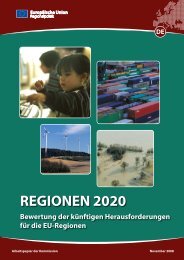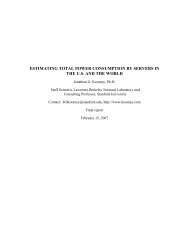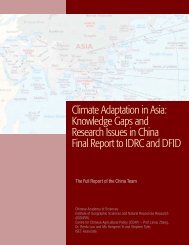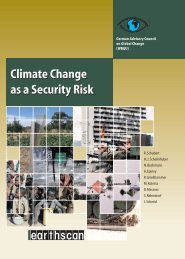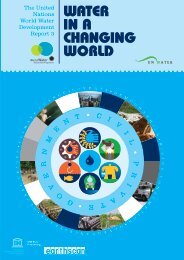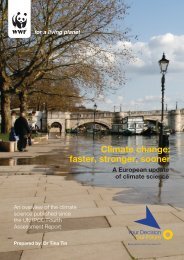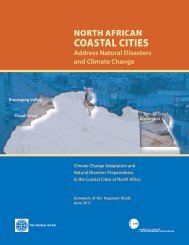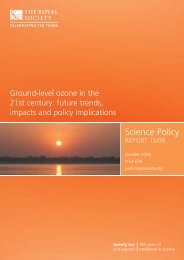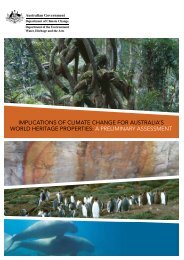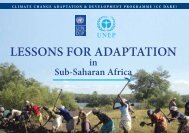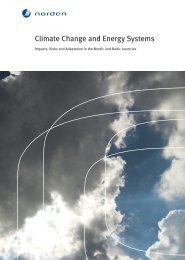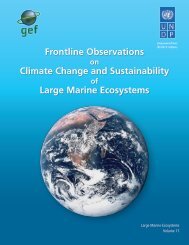Climate change futures: health, ecological and economic dimensions
Climate change futures: health, ecological and economic dimensions
Climate change futures: health, ecological and economic dimensions
Create successful ePaper yourself
Turn your PDF publications into a flip-book with our unique Google optimized e-Paper software.
CLIMATE CHANGE CANOCCUR ABRUPTLYPerhaps the most daunting factor complicating the taskof estimating the future <strong>health</strong> <strong>and</strong> <strong>economic</strong> impactsof climate <strong>change</strong> is that most climate <strong>futures</strong> <strong>and</strong> insuranceindustry projections drastically underestimate therate at which climate might <strong>change</strong>.on linear extrapolations of past trends <strong>and</strong> current trajectories,though the insurance industry has long considered“catastrophe theory” to project the impacts ofsudden, extreme losses. However, these models do notpredict the probabilities of such events. For climate,increasing rates of <strong>change</strong> <strong>and</strong> greater volatility aresigns of instability <strong>and</strong> suggest greater propensity forsudden <strong>change</strong> (Epstein <strong>and</strong> McCarthy 2004).26 | THE CLIMATE CONTEXT TODAYMost envisioned climate <strong>futures</strong> of international assessmentsto date are based on gradual projections ofincreasing temperatures. Some include temperaturevariability, <strong>and</strong> others have begun to examine variancein weather patterns. But most do not reflect thehigh degree of variance in weather that is alreadyoccurring <strong>and</strong> few address the potential consequencesof sudden <strong>change</strong> in impacts or abrupt shifts in climateitself.The notion that climate might <strong>change</strong> suddenly, or shiftfrom state to state, rather than <strong>change</strong> gradually —what Richard Alley calls the “switch” rather than the“dial” model for climate <strong>change</strong> — seemed like a radicalnotion when it first began to take hold in the early1990s. In nature, however, sudden shifts are the rule,not the exception.Steven J. Gould’s conception of evolution as “punctuatedequilibrium” depicts long periods of relative stabilitywith gradual <strong>change</strong>, punctuated by periods of massextinctions. These “interruptions” are then followed bythe explosion of new species with new solutions tonew environmental problems that fit together into newcommunities of organisms.On a more immediate time scale, non-linear <strong>change</strong>sare part of our daily experience. When temperatures<strong>change</strong>, liquid water can suddenly transform into ahard, latticed structure as it freezes or vaporizes, whenit boils. Damage functions are also non-linear. Forexample, hailstones tend to bounce off of windshieldsuntil they reach a critical weight <strong>and</strong> break them.Though abrupt climate <strong>change</strong> is a ubiquitous phenomenon<strong>and</strong> is observed throughout ice, pollen, fossil<strong>and</strong> geological records (NAS 2002), the bias towardgradual, incremental <strong>change</strong> may reflect the constraintsof climate models that represent our best underst<strong>and</strong>ingof how dynamic systems behave. Models have a difficulttime incorporating step-wise <strong>change</strong>s to newstates. Most industries naturally base their projectionsEven more challenging is the observation that <strong>change</strong>sin state can be triggered by small forces that approach(often unforeseen) thresholds or “tipping points” — <strong>and</strong>surpass them. Disease outbreaks can slowly grow inimpact, for example, then suddenly become epidemics.For the climate, the transitions between glacial <strong>and</strong>interglacial warm periods can involve <strong>change</strong>s from5-10°C (9-18°F) in the span of a decade or less(Steffan et al. 2004b). Sudden shifts are sometimesrestricted in geographic scope. At other times there areglobal transformations (Severinghaus et al. 1998;NAS 2002; Alley et al. 2003). Many such “highimpact” events that were considered “low probability”just several years ago now seem to some increasinglylikely (Epstein <strong>and</strong> McCarthy 2004) or inevitable(NAS 2002).TIPPING POINTSPOSSIBLE “CLIMATE SHOCKS” WITH LIMITEDGEOGRAPHIC IMPACTS• Small sections of Greenl<strong>and</strong>, the West Antarctic IceSheet (WAIS) or the Antarctic Peninsula could slipinto the ocean, raising sea levels several inches tofeet over years to several decades.o Meltwater is seeping down through crevasses inGreenl<strong>and</strong>, lubricating the base of large glaciers(Krabill et al. 1999; ACIA 2005).o “Rivers of ice” in the WAIS are acceleratingtoward the Southern Ocean (Shepherd et al.2001; Payne et al. 2004; Thomas et al. 2004).o Recent loss of floating ice shelves along theAntarctic Peninsula removes back pressure from thel<strong>and</strong>-based ice sheets (Rignot <strong>and</strong> Thomas 2002).• Alpine glacial melting could accelerate, inundatingcommunities below <strong>and</strong> diminishing water suppliesfor nations dependent on this source for freshwater.



